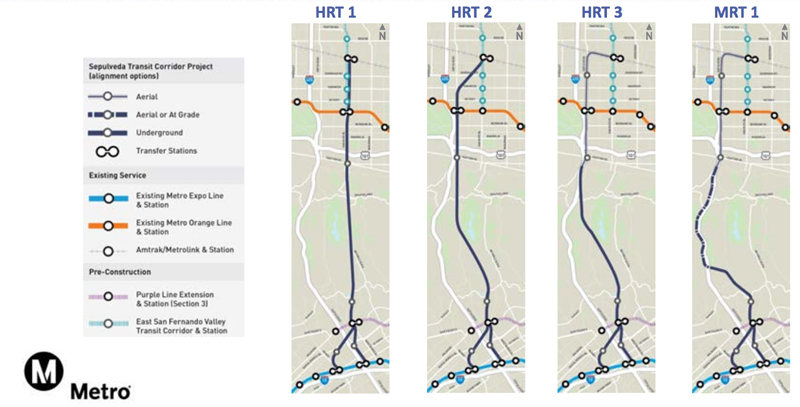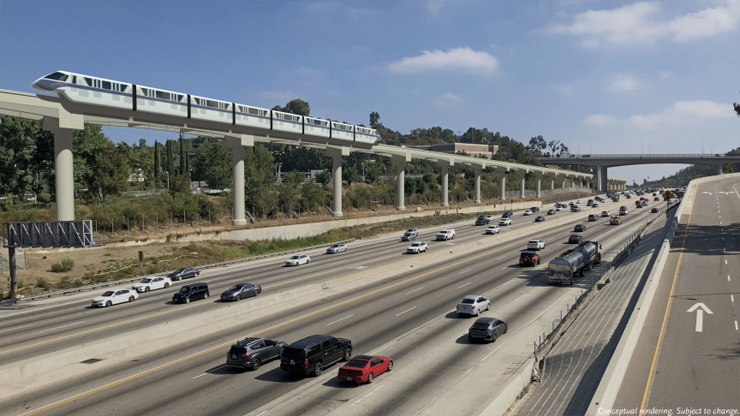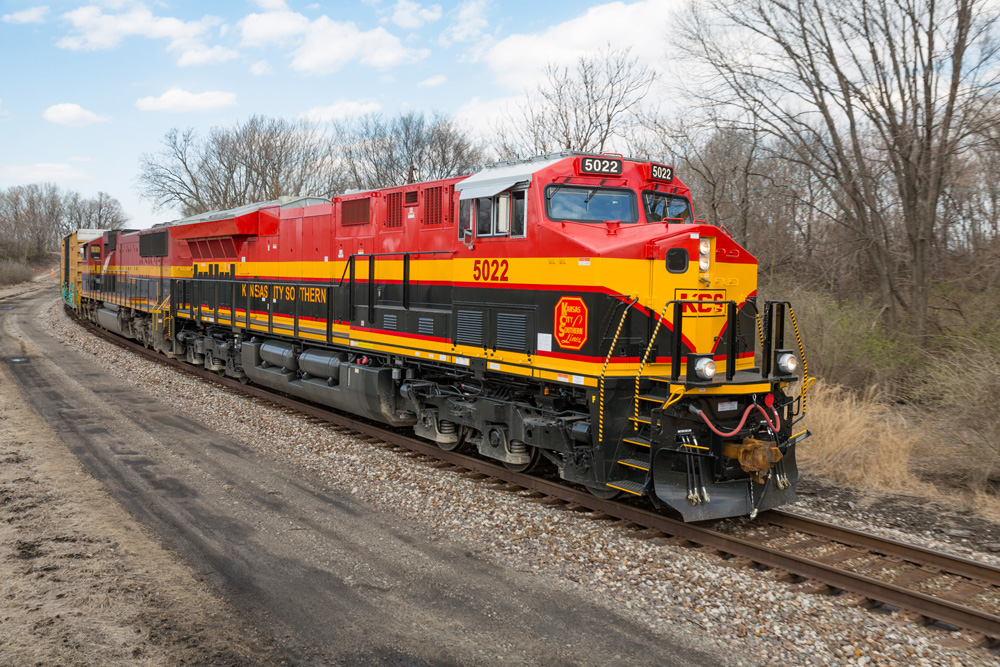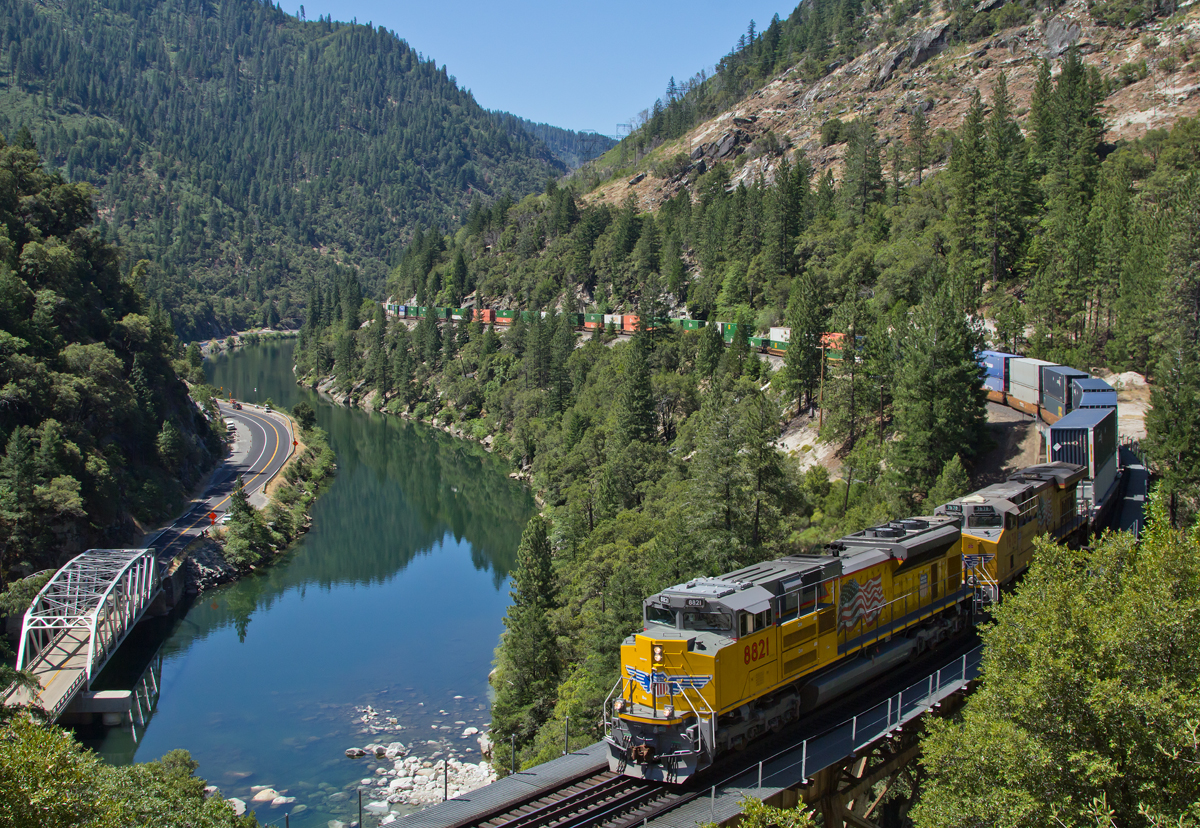Part of an occasional series on L.A. area rail transit projects.
LOS ANGELES — Could LA Metro soon build the nation’s longest, fully autonomous monorail? It’s one of four options being presented to the agency’s board of directors this December, along with three heavy rail alternatives, to bring high-capacity transit to the car-choked Sepulveda corridor.
“We are looking at something that is higher capacity monorail-type service, similar to what we see in other countries, like China, which has the largest monorail line in the world,” explains Cory Zelmer, LA Metro’s project manager for the Sepulveda Transit Corridor project.
Still in the study stage, the project’s goal is to connect the San Fernando Valley with L.A.’s Westside and, in a second phase, with Los Angeles International Airport. Currently, the main transportation option is the heavily congested Interstate 405. Heavy rail or monorail could cut travel times in half.
One of 11 rail projects designated for completion in time for the 2028 Olympics, the Sepulveda line would start at the Metrolink Van Nuys station for connections to Amtrak and the commuter line. It would also connect there with the planned East San Fernando Valley light rail line, which may begin construction in 2022.
But in between the Valley and the Westside stand the Santa Monica Mountains. That means tunneling, and “the more you build something underground the more expensive it is,” says Zelmer.
Two of the three heavy rail concepts would run in a subway for the line’s full length of about 13 miles, but follow slightly different routes, either along Van Nuys Boulevard or Sepulveda Boulevard.
The third heavy rail option would run on an elevated line west from the Metrolink station, above the existing railroad right-of-way, then turn south to continue along Sepulveda Boulevard. South of Ventura Boulevard, in Sherman Oaks, the rail line would descend into a tunnel under the mountains, thereby reducing tunneling costs with a shorter underground segment.
Unlike New York or Chicago, Los Angeles has no other elevated heavy rail line, and noise might be a concern. “That’s something that we would need to study further during the environmental clearance process,” Zelmer says.
Light rail was considered at an earlier stage, but does not have the needed capacity. “This is positioned to be one of the busiest lines in our entire system,” Zelmer tells Trains News Wire. Daily ridership is projected at 122,000 to 137,000.
That’s why monorail was advanced as a fourth alternative. It can climb steeper grades, match heavy rail for capacity, and would require just 35% of the line to be underground. Capital costs are among the lowest of the four alternatives. With driverless trains, operations and maintenance costs are also lower.
Preliminary costs for the three heavy rail options range from $9.9 to $13.5 billion, while the monorail may come in between $9.4 and $11.6 billion.
Included in each alternative would be a new maintenance and storage facility, roughly 20 to 30 acres in size. Three locations are being considered: two near the Metrolink station and one near the Expo Line.
Currently, $5.7 billion is available from Measure M, the Los Angeles County half-cent sales tax approved by voters. Additional funds could come from state or federal sources. Metro is also studying congestion pricing as a way to reduce traffic congestion and raise funds for transit.
Zelmer will deliver the feasibility study outlining these four alternatives next month, but the board won’t act immediately. Instead, the board told Metro earlier this year to secure predevelopment agreements with private firms to further refine the design concepts.
“We’re bringing in parties who would potentially be part of the actual delivery of this project,” explains Zelmer. “We’re bringing them in early so they can contribute to some of these early design challenges that we’re having with the different concepts. They could bring entirely new concepts to the table, and they could help us work out both design solutions and to address any kind of environmental impacts we might be dealing with.”
The request for proposals (RFP) was issued Oct. 31 and the selected firms are expected to be onboard by mid-2020, when the environmental review will begin.
Some community opposition has arisen, mainly in Sherman Oaks, directed toward the elevated rail and monorail options. LA Metro has been holding community meetings and meetings with local neighborhood and business groups.
The San Fernando Valley would be served with three stations for the two subway options and four stations for the elevated heavy rail and monorail alternatives. Four additional stations will serve the Westside: at the UCLA campus; at Wilshire Boulevard where it would connect with phase three of the Purple Line subway, now under construction; at Santa Monica Boulevard; and at the Expo Line.
Projected end-to-end travel time for the heavy rail options are 16-19 minutes. The monorail would take 26 minutes due to its slower running speed.
A future extension beyond the Expo Line to LAX is planned, terminating at the new Airport Metro Connector station on the Crenshaw/LAX line. Most planned routes would be underground. Zelmer says another idea is to continue the Purple Line south to the airport station.
There’s a lot of work ahead if the Sepulveda corridor is to get its transit line in time for the 2028 Summer Olympics.
“Right now, what we’re dealing with is trying to move this forward as quickly as we can,” says Zelmer.
Previous stories in this series:
— LA Metro to prepare for 2028 Olympics with 11 rail projects
— Purple line subway extension tunnels under Los Angeles
— LA Metro on schedule with Blue Line construction work
— LA Metro works to close light rail’s ‘missing link’
















From an efficiency of maintenance logistics, I am continually amazed at the varied different heavy, light, and subway railway vehicles in use in LA. At some point that has to be a Logistics nightmare and more expensive than if they had developed an interchangeable network system.
Jeffrey, I believe the Vancouver skytrain uses a version of it .
In regards Mister McFarlane’s remark concerning getting over Tejon Pass with a monorail.
It would break the concept of a single seat high speed rail link from LA to San Francisco, but it does have the advantage of being able to get over the Tejon Pass, with its infamous six percent five mile grade, without tunneling.
Another option is to go with a rack rail on that stretch. You would have to change motive power at Wheeler Ridge and again at Castaic Junction, but no tunnel would be necessary and you could site it on land already part of the I-5 corridor. This would allow a single-seat solution.
But this article is about the Sepulveda Pass, not about the Grapevine. Let us not hijack the thread.
The above comments are genetic in nature and do not form the basis for an attorney/client relationship. They do not constitute legal advice. I am not your attorney. Turn this thread around, we’re going to Havana.
Mister Tervol:
Bravo Zulu, old boy, for thinking outside the box.
The above comments are genetic in nature and do not form the basis for an attorney/client relationship. They do not constitute legal advice. I am not your attorney. Keep your genes in your dork and your dork in your jeans.
I’m deviating from the original post a bit, but was reading the comments about dealing with grades with varying alternatives (monorail, rack rail, etc.). Particularly in regard to high speed rail. Another option that I wonder about is to simply add a linear induction motor in the high grade segments. For those not familiar, it’s the propulsion approach used in a maglev and for anyone who’s been to an amusement park recently you may have ridden a roller coaster using it. It’s a well established technology, and I imagine could provide more than enough propulsion boost to get a train up a grade. And overcome a stopped train to get it moving again, if needed.
With some design ingenuity I think this could be adapted to an otherwise standard trainset. This could provide a boost beyond what steel wheel on steel rail can deliver, at speed, without stopping to engage/disengage. Where grades are an alternative to tunneling I’d have to suspect this would cost less to build out.
I’m curious if this has been developed/applied anywhere.
Not mentioned anywhere in the article is the solemn fact that getting TO the 405 is often worse than the freeway itself. Tuesday, it took an hour to go 4 miles from downtown Santa Monica to the 405, this starting at 2:15 in the afternoon. Never mind 5:30! Once actually on the 405, traffic moved, as typical at about 30 mph, with occasional slowdowns and stops, but far, far better than the streets leading to the freeway.
As far as it goes, I share Anna’s feelings, good and bad about monorail. Of course the connections on the south end will be light rail or bus anyway, so the one seat ride concept is more or less moot anyway.
As was said, a monorail would not be compatible with the rest of the rail system. Also its slower. While it may be cheaper to build, it is probably more expensive to operate. Also look at other monorail operations that have been discontinued.
Foresight: something that seems to get pushed off to the next election; something that seems to get pushed off to the next election cycle; something that gets pushed off to the next election cycle; etc, etc, etc.
If you have ever been over the Sepulveda Grade during rush hour you will know the pressing need to take some of the pressure off the 405 corridor.
All other things being equal I would like to see a monorail for this project. However, there are two problems with that. Using a monorail obviates the possibility of a single-seat ride into the Metrolink system; and there is public perception concerning monorails from “Marge vs. the Monorail”. Yes, such things do resonate in the public weal.
On the other hand it would be lower cost (due to a decreased need for tunneling) and quicker to install, and a monorail can handle steeper grades than can an adhesion based heavy rail.
In 1963 Alweg Monorail Company offered to build, at its own expense, a monorail system for Los Angeles County, and to turn over an operating turnkey system to (at the time) SCRTD. The offer was rejected in favour of no system at all. I have seen some of the documentation concerning alternatives at the time, including the various vested interests involved in this decision. My opinion of the decision, and of these vested interest is something I think I shall keep to myself.
The above comments are genetic in nature and do not form the basis for an attorney/client relationship. They do not constitute legal advice. I am not your attorney. Monorail rides require an “E” ticket.
Anna: I’ve already been a secret admirer of your insightful, enlightening comments and your clever disclaimers. Now you up your game with a Simpsons reference? Thanks for your part in making this a fun and educational forum for relative novices like me.
Having lived in the Los Angeles area for about 8 years in the 60’s and been back many times, the I-405 through Sepulveda Pass is a mess and in fact just like in the Seattle area the entire I 405 corridor is most times a parking lot in the Los Angeles metro area.
I agree with Gerald, ask Japan. Japan has multiple over 90% farebox return trains, let alone construction Ingenuity. But this is California, Whatever they choose, will FAIL!! HSR? Remember? “The beatings will continue until morale is increased”
I haven’t been on the 405 Freeway in 46 years (or anywhere in SoCal in 46 years) but I can believe it’s a disaster. The freeway was pretty much a disaster back then.
I have to believe that the existing format of cars/ tracks on the LA Metro could handle the various grades and the other demands of this corridor. Introducing another format – a monorail – seems a very expensive problem waiting to happen.
As always and everywhere, rail provides an alternative to highway congestion but doesn’t provide enough diversion to mitigate highway congestion.
Michael Moss, did you not read the story? It states that maintenance and operations would be less expensive than the heavy rail options…less expensive = cheaper, not more costly.
David Wire, that’s true, but they should be looking at Japan and not China for inspiration, Japan has several monorails that are used for public transit…and I’m sure there’s something that could be done about the speed.
As an aside…it was interesting to note that the ICE 3 and 4 in Germany are designed to operate at high speeds on grades up to 4%…I think whomever is in charge at CAHSR should look into using those trainsets in a combination routing over/through the Southern California mountains and for a route into the Bay Area via Altamont and/or the current planned routing via Gilroy.